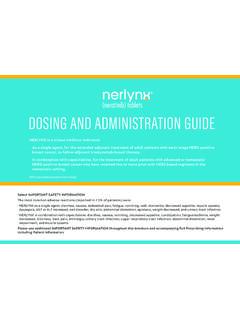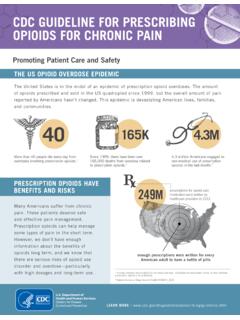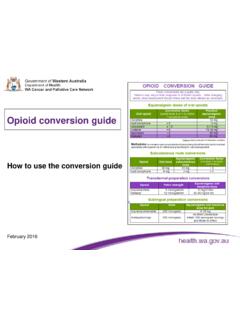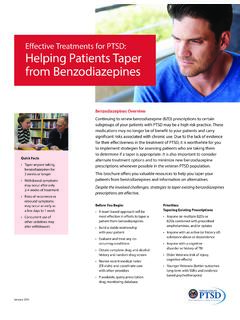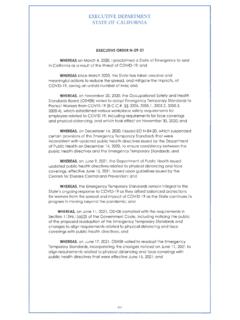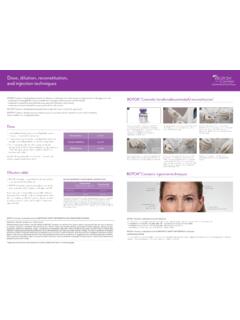Transcription of HIGHLIGHTS OF PRESCRIBING INFORMATION Diarrhea ...
1 HIGHLIGHTS OF PRESCRIBING INFORMATION These HIGHLIGHTS do not include all the INFORMATION needed to use NERLYNX safely and effectively. See full PRESCRIBING INFORMATION for NERLYNX. NERLYNX (neratinib) tablets, for oral use Initial Approval: 2017 _____ INDICATIONS AND USAGE _____ NERLYNX is a kinase inhibitor indicated for the extended adjuvant treatment of adult patients with early stage HER2-overexpressed/amplified breast cancer, to follow adjuvant trastuzumab-based therapy. (1, 14) _____ DOSAGE AND ADMINISTRATION _____ Antidiarrheal prophylaxis: Initiate loperamide with the first dose of NERLYNX and continue during first 2 cycles (56 days) of treatment. Instruct patients to maintain 1-2 bowel movements per day and on how to use antidiarrheal treatment regimens. ( ) Recommended dose : 240 mg (6 tablets) given orally once daily with food, continuously for one year. ( ) dose interruptions and/or dose reductions are recommended based on individual safety and tolerability.
2 ( ) Hepatic Impairment: Reduce starting dose to 80 mg in patients with severe hepatic impairment. ( ) _____ DOSAGE FORMS AND STRENGTHS _____ Tablets: 40 mg. (3) _____ CONTRAINDICATIONS _____ None. (4) _____ WARNINGS AND PRECAUTIONS _____ Diarrhea : Aggressively manage Diarrhea occurring despite recommended prophylaxis with additional antidiarrheals, fluids, and electrolytes as clinically indicated. Withhold NERLYNX in patients experiencing severe and/or persistent Diarrhea . Permanently discontinue NERLYNX in patients experiencing Grade 4 Diarrhea or Grade 2 Diarrhea that occurs after maximal dose reduction. ( , ) Hepatotoxicity: Monitor liver function tests monthly for the first 3 months of treatment, then every 3 months while on treatment and as clinically indicated. Withhold NERLYNX in patients experiencing Grade 3 liver abnormalities and permanently discontinue NERLYNX in patients experiencing Grade 4 liver abnormalities. ( , ) Embryo-Fetal Toxicity: NERLYNX can cause fetal harm.
3 Advise patients of potential risk to a fetus and to use effective contraception. ( , , ) _____ ADVERSE REACTIONS _____ The most common adverse reactions (> 5%) were Diarrhea , nausea, abdominal pain, fatigue, vomiting, rash, stomatitis, decreased appetite, muscle spasms, dyspepsia, AST or ALT increase, nail disorder, dry skin, abdominal distention, weight decreased and urinary tract infection. (6) To report SUSPECTED ADVERSE REACTIONS, contact Puma Biotechnology, Inc. at 1-844-NERLYNX (1-844-637-5969) or FDA at 1-800-FDA-1088 or _____ DRUG INTERACTIONS _____ Gastric acid reducing agents: Avoid concomitant use with proton pump inhibitors (PPI) and H2-receptor antagonists. Separate NERLYNX by 3 hours after antacid dosing. ( , ) Strong or moderate CYP3A4 inhibitors: Avoid concomitant use. ( ) Strong or moderate CYP3A4 inducers: Avoid concomitant use. ( ) P-glycoprotein (P-gp) substrates: Monitor for adverse reactions of narrow therapeutic agents that are P-gp substrates when used concomitantly with NERLYNX.
4 ( ) _____ USE IN SPECIFIC POPULATIONS _____ Lactation: Advise women not to breastfeed. ( ) See 17 for PATIENT COUNSELING INFORMATION and FDA approved patient labeling. Revised: 07/2017 FULL PRESCRIBING INFORMATION : CONTENTS* 1 INDICATIONS AND USAGE 2 DOSAGE AND ADMINISTRATION Antidiarrheal Prophylaxis Recommended dose and Schedule dose Modifications 3 DOSAGE FORMS AND STRENGTHS 4 CONTRAINDICATIONS 5 WARNINGS AND PRECAUTIONS Diarrhea Hepatotoxicity Embryo-Fetal Toxicity 6 ADVERSE REACTIONS Clinical Trials Experience 7 DRUG INTERACTIONS Effect of Other Drugs on NERLYNX Effect of NERLYNX on Other Drugs 8 USE IN SPECIFIC POPULATIONS Pregnancy Lactation Females and Males of Reproductive Potential Pediatric Use Geriatric Use Hepatic Impairment 10 OVERDOSAGE 11 DESCRIPTION 12 CLINICAL PHARMACOLOGY Mechanism of Action Pharmacodynamics Pharmacokinetics 13 NONCLINICAL TOXICOLOGY Carcinogenesis, Mutagenesis, Impairment of Fertility 14 CLINICAL STUDIES Extended Adjuvant Treatment in Breast Cancer 16 HOW SUPPLIED/STORAGE AND HANDLING 17 PATIENT COUNSELING INFORMATION *Sections or subsections omitted from the full PRESCRIBING INFORMATION are not listed.
5 FULL PRESCRIBING INFORMATION 1 INDICATIONS AND USAGE NERLYNX is indicated for the extended adjuvant treatment of adult patients with early stage HER2-overexpressed/amplified breast cancer, to follow adjuvant trastuzumab based therapy [see Clinical Studies (14)]. 2 DOSAGE AND ADMINISTRATION Antidiarrheal Prophylaxis Antidiarrheal prophylaxis is recommended during the first 2 cycles (56 days) of treatment and should be initiated with the first dose of NERLYNX [see Dosage and Administration ( ) and Warnings and Precautions ( )]. Instruct patients to take loperamide as directed in Table 1, titrating to 1-2 bowel movements per day. Table 1: Loperamide Prophylaxis Time on NERLYNX dose Frequency Weeks 1-2 (days 1 - 14) 4 mg Three times daily Weeks 3-8 (days 15 - 56) 4 mg Twice daily Weeks 9-52 (days 57 365) 4 mg As needed (not to exceed 16 mg per day) Additional antidiarrheal agents may be required to manage Diarrhea in patients with loperamide-refractory Diarrhea . NERLYNX dose interruptions and dose reductions may also be required to manage Diarrhea [see Dosage and Administration ( )].
6 Recommended dose and Schedule The recommended dose of NERLYNX is 240 mg (six tablets) given orally once daily with food, continuously for one year. Instruct patients to take NERLYNX at approximately the same time every day. NERLYNX tablets should be swallowed whole (tablets should not be chewed, crushed, or split prior to swallowing). If a patient misses a dose , do not replace missed dose , and instruct the patient to resume NERLYNX with the next scheduled daily dose . dose Modifications dose Modifications for Adverse Reactions NERLYNX dose modification is recommended based on individual safety and tolerability. Management of some adverse reactions may require dose interruption and/or dose reduction as shown in Table 2 to Table 5. Discontinue NERLYNX for patients who fail to recover to Grade 0-1 from treatment-related toxicity, for toxicities that result in a treatment delay > 3 weeks, or for patients that are unable to tolerate 120 mg daily. Additional clinical situations may result in dose adjustments as clinically indicated ( intolerable toxicities, persistent Grade 2 adverse reactions, etc.)
7 Table 2: NERLYNX dose Modifications for Adverse Reactions dose Level NERLYNX dose Recommended starting dose 240 mg daily First dose reduction 200 mg daily Second dose reduction 160 mg daily Third dose reduction 120 mg daily Table 3: NERLYNX dose Modifications and Management General Toxicities1 Severity of Toxicity2 Action Grade 3 Hold NERLYNX until recovery to Grade 1 or baseline within 3 weeks of stopping treatment. Then resume NERLYNX at the next lower dose level. Grade 4 Discontinue NERLYNX permanently. 1 Refer to Table 4 and Table 5 below for management of Diarrhea and hepatotoxicity 2 Per CTCAE dose Modifications for Diarrhea Diarrhea management requires the correct use of antidiarrheal medication, dietary changes, and appropriate dose modifications of NERLYNX. Guidelines for adjusting doses of NERLYNX in the setting of Diarrhea are shown in Table 4. Table 4: dose Modifications for Diarrhea Severity of Diarrhea1 Action Grade 1 Diarrhea [increase of < 4 stools per day over baseline] Grade 2 Diarrhea [increase of 4-6 stools per day over baseline] lasting < 5 days Grade 3 Diarrhea [increase of 7 stools per day over baseline; incontinence; hospitalization indicated; limiting self-care activities of daily living] lasting < 2 days Adjust antidiarrheal treatment Diet modifications Fluid intake of ~2L should be maintained to avoid dehydration Once event resolves to Grade 1 or baseline, start loperamide 4 mg with each subsequent NERLYNX administration.
8 Any grade with complicated features2 Grade 2 Diarrhea lasting five days or longer3 Grade 3 Diarrhea lasting longer than 2 days3 Interrupt NERLYNX treatment Diet modifications Fluid intake of ~2L should be maintained to avoid dehydration If Diarrhea resolves to Grade 0-1 in one week or less, then resume NERLYNX treatment at the same dose . If Diarrhea resolves to Grade 0-1 in longer than one week, then resume NERLYNX treatment at reduced dose (see Table 2). Once event resolves to Grade 1 or baseline, start loperamide 4 mg with each subsequent NERLYNX administration. Grade 4 Diarrhea [Life-threatening consequences; urgent intervention indicated] Permanently discontinue NERLYNX treatment Diarrhea recurs to Grade 2 or higher at 120 mg per day Permanently discontinue NERLYNX treatment 1 Per CTCAE 2 Complicated features include dehydration, fever, hypotension, renal failure, or Grade 3 or 4 neutropenia 3 Despite being treated with optimal medical therapy dose Modifications for Hepatic Impairment Reduce the NERLYNX starting dose to 80 mg in patients with severe hepatic impairment (Child Pugh C).
9 No dose modifications are recommended for patients with mild to moderate hepatic impairment (Child Pugh A or B) [see Use in Specific Populations ( ) and Clinical Pharmacology ( )]. dose Modifications for Hepatotoxicity Guidelines for dose adjustment of NERLYNX in the event of liver toxicity are shown in Table 5. Patients who experience Grade 3 Diarrhea requiring IV fluid treatment or any signs or symptoms of hepatotoxicity, such as worsening of fatigue, nausea, vomiting, right upper quadrant pain or tenderness, fever, rash, or eosinophilia, should be evaluated for changes in liver function tests. Fractionated bilirubin and prothrombin time should also be collected during hepatotoxicity evaluation [see Warnings and Precautions ( )]. Table 5: dose Modifications for Hepatotoxicity Severity of Hepatoxicity1 Action Grade 3 ALT (>5-20x ULN) OR Grade 3 bilirubin (>3-10x ULN) Hold NERLYNX until recovery to Grade 1 Evaluate alternative causes Resume NERLYNX at the next lower dose level if recovery to Grade 1 occurs within 3 weeks.
10 If Grade 3 ALT or bilirubin occurs again despite one dose reduction, permanently discontinue NERLYNX Grade 4 ALT (>20x ULN) OR Grade 4 bilirubin (>10x ULN) Permanently discontinue NERLYNX Evaluate alternative causes 1 Per CTCAE Concomitant Use with Gastric Acid Reducing Agents Proton pump inhibitors (PPI): Avoid concomitant use with NERLYNX [see Drug Interactions ( )]. H2-receptor antagonists: Avoid concomitant use with NERLYNX [see Drug Interactions ( )]. Antacids: Separate dosing of NERLYNX by 3 hours after antacids [see Drug Interactions ( )]. 3 DOSAGE FORMS AND STRENGTHS Tablets: 40 mg neratinib (equivalent to mg of neratinib maleate). Film-coated, red, oval shaped and debossed with W104 on one side and plain on the other side. 4 CONTRAINDICATIONS None. 5 WARNINGS AND PRECAUTIONS Diarrhea Severe Diarrhea and sequelae, such as dehydration, hypotension, and renal failure, have been reported during treatment with NERLYNX.
